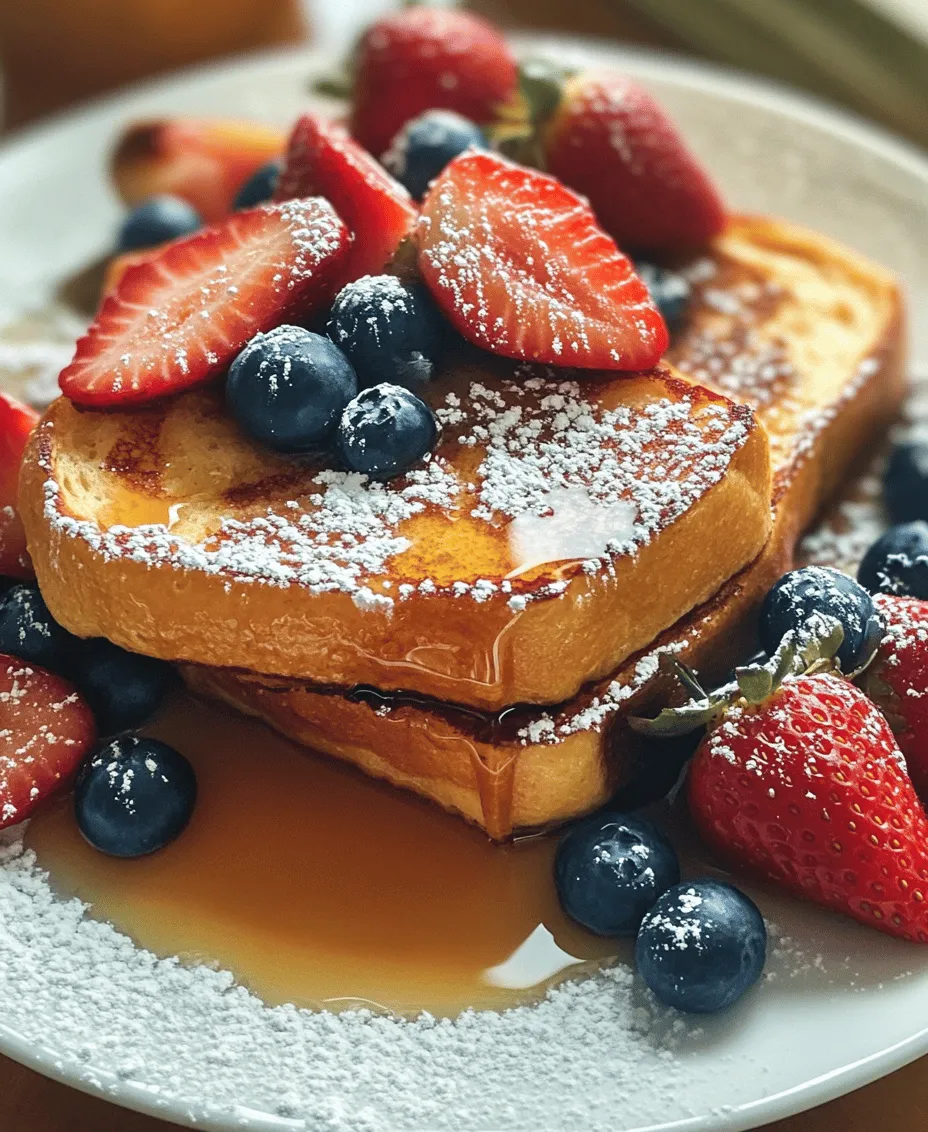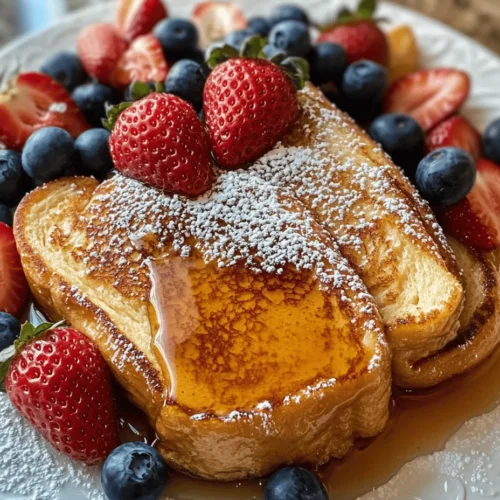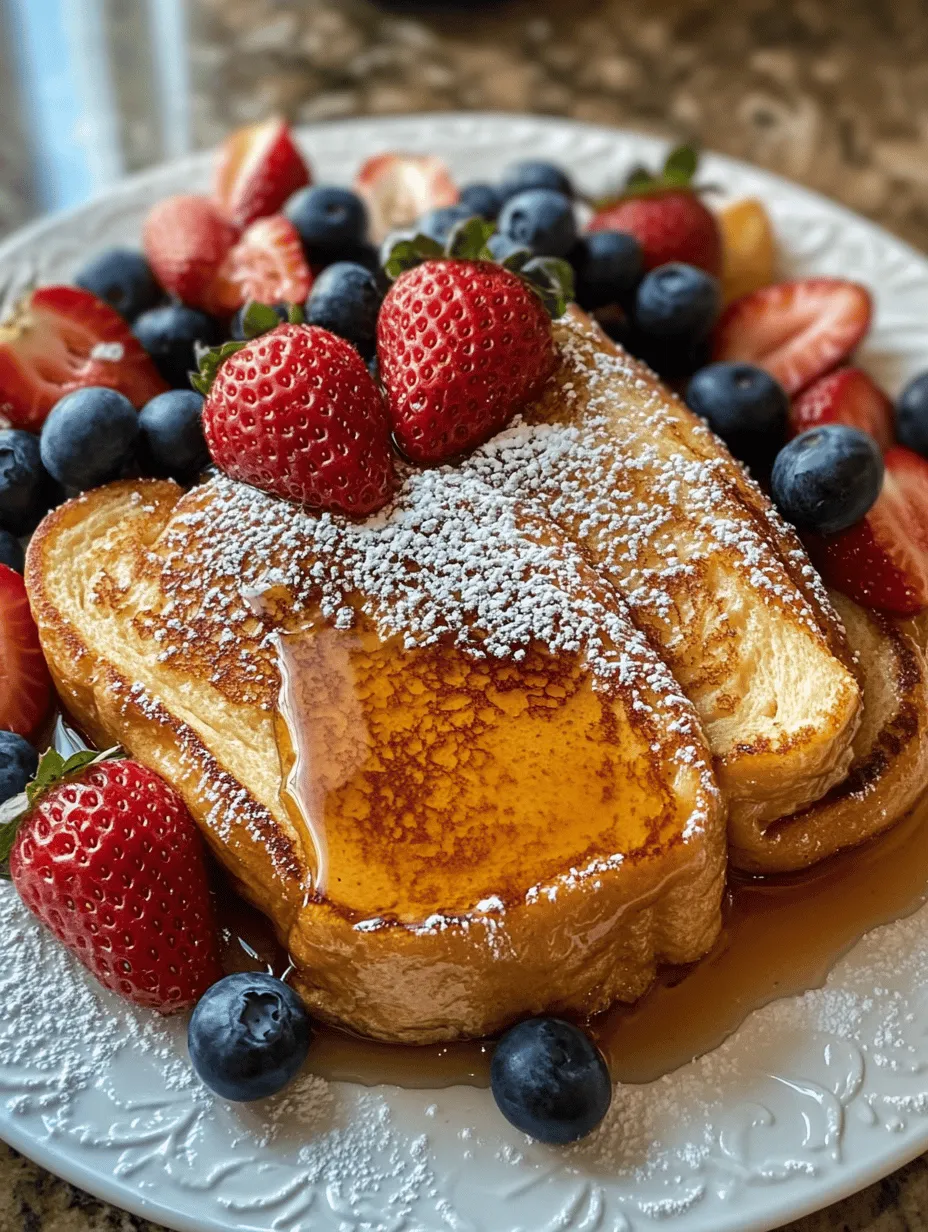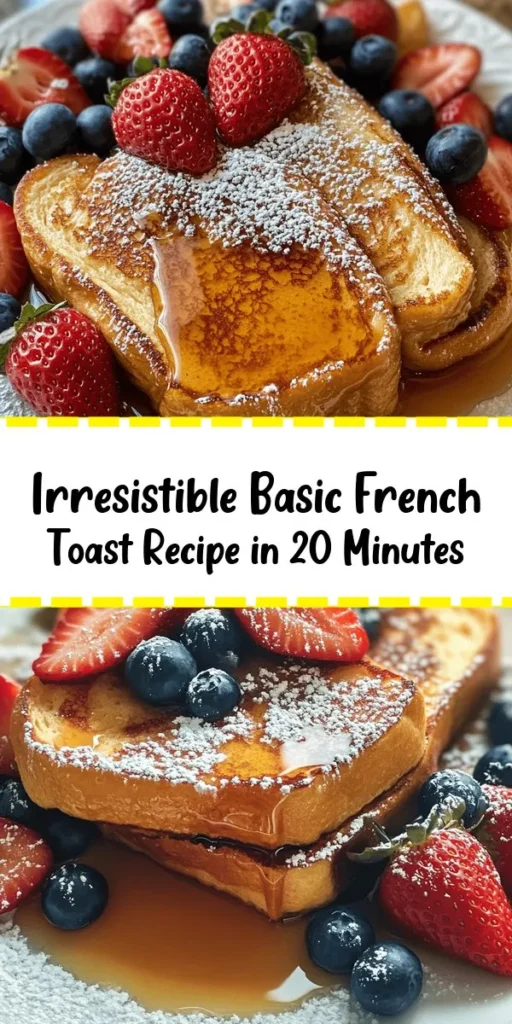Introduction
French toast, a beloved breakfast staple, has captured the hearts and taste buds of food enthusiasts around the world. This simple yet delightful dish transforms humble ingredients into a luxurious morning experience, making it a go-to choice for brunch gatherings or cozy family breakfasts. The beauty of French toast lies in its versatility and ease of preparation, allowing anyone to whip up a delicious meal even on the busiest of mornings.
To achieve a truly heavenly French toast, however, the selection of ingredients is paramount. The right bread, eggs, and flavorings can elevate this classic dish from ordinary to extraordinary. In a fast-paced lifestyle where convenience often trumps quality, the allure of homemade breakfast options becomes increasingly appealing. Not only does preparing your own French toast allow you to control the ingredients, but it also provides an opportunity to connect with the culinary traditions that have made this dish a favorite for generations.
Understanding French Toast
The origins of French toast trace back to ancient times, with roots in various cultures around the globe. The dish is believed to have first appeared in Roman times, where bread was soaked in a mixture of milk and eggs, then fried to create a satisfying meal. Over the centuries, French toast has evolved, with each culture adding its own unique twist. In France, it is known as “pain perdu,” or “lost bread,” referring to the practice of using stale bread that might otherwise go to waste. In contrast, variations in other countries incorporate local ingredients and flavors, showcasing the dish’s adaptability and enduring popularity.
From a nutritional standpoint, French toast can offer several benefits when made with wholesome ingredients. The primary component, bread, provides carbohydrates for energy, while eggs contribute protein, essential for muscle repair and growth. By choosing whole-grain or enriched bread, you can also increase the fiber content of your meal. Additionally, incorporating nutritious toppings like fresh fruits, nuts, or yogurt can enhance the health benefits of this classic breakfast dish, making it not just delicious but also nourishing.
Key Ingredients for Perfect French Toast
Creating the ultimate French toast begins with understanding the essential ingredients that contribute to its rich flavor and delectable texture. Here’s a breakdown of what you’ll need:
Thick Bread Types: Exploring Brioche and Challah
The foundation of any great French toast is the bread. For a truly indulgent experience, opt for thick slices of brioche or challah. Brioche, a French bread enriched with butter and eggs, offers a soft, tender crumb that soaks up the custard beautifully. On the other hand, challah, a traditional Jewish bread, features a slightly sweet flavor and a rich, eggy texture that makes it perfect for French toast. Both options provide a delightful base that can elevate your dish to heavenly heights.
The Role of Eggs in Creating a Rich Custard Base
Eggs are a crucial component in the custard mixture that transforms your bread into French toast. They not only bind the ingredients together but also provide a creamy richness that enhances the overall flavor. When whisked together with milk and other flavorings, eggs create a luscious custard that seeps into the bread, ensuring each bite is bursting with flavor. Using large eggs is standard in most recipes, but feel free to experiment with egg substitutes if you’re looking for a lighter or vegan version.
The Significance of Whole Milk for Texture and Flavor
Whole milk is the ideal choice for creating the custard base for French toast. Its creamy consistency adds depth and richness to the mixture, resulting in a luscious texture that perfectly complements the bread. While you can use lower-fat milk or non-dairy alternatives, whole milk provides the best flavor and mouthfeel, ensuring a satisfying breakfast experience. For an even creamier result, consider adding a splash of heavy cream or half-and-half to your custard mixture.
Sweetening Agents: Why Granulated Sugar Enhances Taste
To balance the flavors in your French toast, a touch of sweetness is essential. Granulated sugar is commonly used in the custard mixture, helping to enhance the overall taste without overpowering the other ingredients. Not only does sugar contribute sweetness, but it also aids in caramelization during cooking, creating a beautiful golden-brown crust on the outside of your French toast. If you prefer a more natural sweetener, alternatives like maple syrup or honey can also be used, but be sure to adjust the amounts accordingly.
Flavor Enhancers: Vanilla Extract and Ground Cinnamon
To elevate the flavor profile of your French toast, consider incorporating vanilla extract and ground cinnamon into the custard mixture. Vanilla extract adds a warm, aromatic quality that pairs beautifully with the richness of the eggs and milk, while cinnamon introduces a hint of spice that complements the sweetness. Together, these flavor enhancers create a comforting and inviting dish that will have your taste buds dancing with joy.
Understanding the Role of Salt in Balancing Sweetness
While it may seem counterintuitive, a pinch of salt is essential in balancing the sweetness of your French toast. Salt enhances flavors and helps to create a more complex taste profile. It amplifies the sweetness of the sugar while also cutting through the richness of the custard, ensuring that each bite is well-rounded and satisfying. Use a small amount—about 1/4 teaspoon should suffice—to achieve the perfect balance without making the dish taste salty.
Step-by-Step Guide to Making Heavenly Basic French Toast
Now that you understand the key ingredients that make up heavenly French toast, let’s dive into the step-by-step process of creating this delicious breakfast dish. Follow these detailed instructions to ensure your French toast turns out perfectly every time.
Step 1: Gather Your Ingredients
Before you begin, gather all the necessary ingredients and tools. You will need:
– 4 large eggs
– 1 cup whole milk
– 2 tablespoons granulated sugar
– 1 teaspoon vanilla extract
– 1/2 teaspoon ground cinnamon
– A pinch of salt
– 8 slices of thick bread (brioche or challah)
– Butter or oil for cooking
Make sure you have a large mixing bowl, a whisk, a shallow dish for soaking the bread, and a non-stick skillet or griddle ready for cooking.
Step 2: Prepare the Custard Mixture
In a large mixing bowl, crack the eggs and whisk them thoroughly until they are well beaten. Add the whole milk, granulated sugar, vanilla extract, ground cinnamon, and a pinch of salt to the bowl. Continue whisking until all the ingredients are fully combined and the mixture is smooth. This custard base is what will soak into the bread, creating that rich, luscious texture we all love in French toast.
Step 3: Soak the Bread Slices
Take your slices of brioche or challah and place them in the shallow dish. Pour the custard mixture over the bread, ensuring that each slice is generously coated. Allow the bread to soak for about 2-3 minutes on each side, giving it enough time to absorb the custard without becoming overly soggy. The goal is to achieve a perfect balance where the bread is moist but not falling apart.
Step 4: Preheat Your Cooking Surface
While the bread is soaking, preheat your non-stick skillet or griddle over medium heat. To ensure even cooking and a golden-brown crust, it’s important to get your cooking surface hot before adding the bread. Once the skillet is warm, add a tablespoon of butter or oil, allowing it to melt and coat the surface evenly.
Step 5: Cook the French Toast
Once the skillet is hot and the butter has melted, carefully place the soaked bread slices onto the skillet. Avoid overcrowding the pan; cook in batches if necessary to ensure even cooking. Allow the French toast to cook for about 3-4 minutes on one side, or until it turns a beautiful golden brown. Use a spatula to gently flip the slices over and cook for an additional 2-3 minutes on the other side.
Step 6: Serve and Enjoy
As each batch of French toast finishes cooking, transfer the slices to a warm plate or a low-temperature oven to keep them warm while you finish cooking the remaining pieces. Serve the French toast immediately, topped with your favorite accompaniments, such as maple syrup, fresh berries, whipped cream, or a dusting of powdered sugar.
By following these steps, you will create a plate of heavenly French toast that is sure to impress family and friends alike. Stay tuned for more tips and variations on this classic dish, as there’s so much more to explore in the world of French toast!

Preparing the Egg Mixture
To create the perfect French toast, the egg mixture is crucial. Start by cracking your eggs into a mixing bowl. Use fresh eggs for the best flavor and texture. Whisk them vigorously until the yolks and whites are fully blended. For a smooth and creamy consistency, consider using a hand mixer or an immersion blender. This technique incorporates air into the mixture, resulting in a lighter texture that clings beautifully to the bread.
Next, add your milk or cream. Whole milk will produce a rich flavor, while half-and-half or cream will create a decadently custardy base. For those looking to cut calories, almond milk or oat milk can be great alternatives, maintaining the creamy texture without the dairy. Sprinkle in a pinch of salt to enhance the sweetness and balance the flavors. Don’t forget to add your spices—cinnamon is traditional, but a touch of nutmeg can elevate the flavor profile. For a unique twist, consider adding a splash of vanilla extract or a drop of almond extract to your mixture. Once combined, let the mixture sit for a few minutes to allow the flavors to meld.
The Importance of Soaking Time for Bread Slices
Soaking your bread slices is vital for achieving that classic French toast texture. The goal is to allow the bread to absorb enough of the egg mixture without becoming overly soggy. For most breads, a soaking time of about 10 to 15 seconds per side is ideal. This short soak ensures that the bread becomes saturated enough to hold the custard but not so much that it falls apart during cooking.
If you’re using denser breads like sourdough or brioche, you may want to extend the soaking time slightly, up to 20 seconds per side, as they can absorb more liquid. Conversely, lighter breads like white sandwich bread should be soaked for the shorter duration, as they can become mushy more quickly. Experimenting with different soaking times can lead to discovering your perfect texture.
Tips for Achieving the Perfect Golden Brown Crust
The crust is what makes French toast irresistible, and achieving that perfect golden brown hue requires a few key tips. First, ensure your skillet is preheated properly. A medium heat setting is usually ideal—too high a temperature will burn the outside while leaving the inside undercooked.
When cooking French toast, use a non-stick skillet or griddle for the best results. Add a generous pat of butter to the pan. Not only does this add incredible flavor, but it also creates a beautiful, crispy exterior. Allow the butter to melt and bubble before adding your soaked bread slices.
Cook each slice for 2 to 3 minutes on the first side, or until it reaches a rich, golden brown. Avoid the temptation to flip too soon; patience is key. Once flipped, allow the second side to cook for another 2 minutes. If you find that the bread is browning too quickly, lower the heat slightly to ensure even cooking throughout.
Cooking Techniques
Achieving the ideal French toast requires attention to cooking techniques. The optimal skillet temperature is crucial for even cooking. Start by warming your skillet over medium heat. A good test for readiness is to sprinkle a few drops of water on the surface; if they dance and evaporate quickly, your pan is ready.
For a rich flavor and to prevent sticking, use unsalted butter, as it allows you to control the sodium level in your dish. Add butter just before placing the bread in the skillet, allowing it to foam slightly before laying the bread down. This will create a luscious golden crust that is both crispy and flavorful.
If you’re making a large batch, consider using an oven to keep the French toast warm. Preheat your oven to 200°F (93°C) and place the cooked slices on a baking sheet in a single layer. This method keeps them warm and crispy until you’re ready to serve.
Serving Suggestions
Once your French toast is cooked to perfection, the fun part begins: serving it! Traditional toppings like maple syrup are a must. There are countless varieties of maple syrup, from light to dark, each offering a unique flavor profile. Dark syrup tends to have a more robust taste, adding a deeper sweetness that pairs wonderfully with the custardy toast.
Fresh fruits are another excellent option for topping your French toast. Seasonal fruits like strawberries, blueberries, or peaches can add a burst of color and nutrition. Slicing up ripe bananas or drizzling with honey is also a great way to enhance the dish. Consider creating a vibrant fruit compote with a mix of your favorite berries for an extra special touch.
For a final flourish, a dusting of powdered sugar can provide an attractive presentation, while also balancing the richness of the dish. Additionally, a dollop of whipped cream or a sprinkle of nuts can introduce exciting textures and flavors that elevate your French toast experience.
Variations on the Classic Recipe
French toast is a versatile dish that welcomes creativity. Exploring different types of bread can significantly alter the flavor and texture of your dish. Sourdough offers a tangy contrast, while whole grain bread adds depth and heartiness. For those with dietary restrictions, gluten-free bread can be easily substituted without sacrificing taste.
Flavor variations can take your French toast to the next level. Incorporating spices like nutmeg or vanilla extract will enhance the custard flavor. For a bright, refreshing twist, add citrus zest from oranges or lemons to your egg mixture.
If you’re feeling adventurous, consider savory French toast options. Adding cheese, such as goat cheese or sharp cheddar, can create a delightful contrast to the sweetness. Incorporating fresh herbs like basil or thyme, or even sautéed vegetables like spinach or mushrooms, can transform your breakfast into a gourmet experience.
Conclusion
Homemade French toast is a delightful way to start your day. Its simplicity and versatility allow for endless customization and creativity, making it a breakfast staple for many. Whether you choose to stick with the classic maple syrup or explore unique toppings and variations, the joy of crafting this dish lies in its ability to be personalized.
We encourage you to experiment with different breads, flavors, and toppings to make this recipe your own. The satisfaction of enjoying a homemade breakfast, made from scratch, is unmatched. So gather your ingredients, invite friends or family, and indulge in the heavenly experience of French toast that’s not just a meal but a cherished moment shared.



